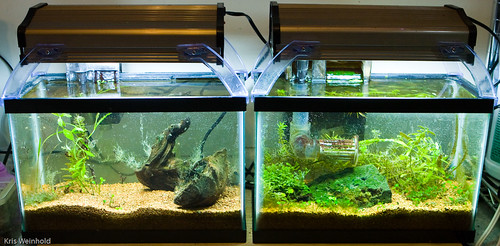Wormstrate/Soil – Winners and Loser
June 30th, 2008I am concluding my comparison of the soil and worm-casting-based substrates. The picture below sums it all up — neither tank met or exceeded my expectations. Now, in this case, the winner appears to be the wormstrate, but in truth, there is no winner, and the biggest loser is me.
Unfortunately, I wasn’t able to really conduct a fair experiment for these two tanks. I rarely dosed any Excel, and the lights themselves probably made the tanks too warm to successfully grow many plants. Factor in my travels recently, and it adds up to a lot of neglect. I’m amazed that the wormstrate was able to maintain a growing carpet of Marsilea quadrifolia. The soil tank on the other hand, saw nearly all of the plant life disappear. The only plant that really did well in that tank was Limnophila aquatica (now removed), which grows in just about anything. I want to make clear that this is not an indictment of soil substrates because I know many GWAPA members who have absolutely amazing results with soil. It’s only a failure of execution on my behalf. So, I’m tearing down the soil substrate tank, and am finally going to set up my 2.5G aquascape for the GWAPA contest. I have until October 1st to make it into something fabulous!

June 30th, 2008 at 10:13 pm
What is growing on the rock? It’s beautiful!
July 1st, 2008 at 5:48 am
The plant growing on the rock on the left is Subwassertang (freshwater seaweed). It’s a liverwort, and quite similar to pellia.
July 1st, 2008 at 1:25 pm
Good that you tried the experiment all the same. I suspect in the end it said more about the plants than the substrate but all credit to you for at least attempting to see a comparison. So much advice given on growing aquarium plants still amounts to folklore.
July 1st, 2008 at 1:44 pm
Phillip, you’re probably correct that some of the plants, such as the Eriocaulon sp. ‘Type 2’ definitely failed because it is more of a water feeder, than a root feeder. I later confirmed this with other GWAPA members who have tried this particular plant in soil. But some of the other plants, such as Rotala rotundifolia should thrive in just about any condition, (including other confirmations of growing well in soil), but didn’t in my experiment. All of the plants I’ve used came from other tanks where they were thriving. At some point, I hope to setup larger tanks with each of these methods, and devote more time to their upkeep to see how they really fare. Thanks for the comment!
July 2nd, 2008 at 12:36 am
Kris, do you think that this soil substrate just doesn’t translate well to the smaller scale of 2.5 gal? How much inert capping did you use? I think that your assumption that the lighthouse fixture is generating to much heat and having ill-effects on your flora is correct. Final question, If you were to do it all over again what would change? Anyway excellent experiment, regardless of outcome.
July 2nd, 2008 at 7:04 am
Jon, I think the soil would work just fine in any size tank. I didn’t have any problems with water clarity, so I don’t think I used too little inert capping. Since I tore it down, I don’t have an exact measurement, but say 1.5 inches on top of the soil. If I were to do it over again, the main thing I would do is make sure I have CO2 in the tank. That makes such a difference!